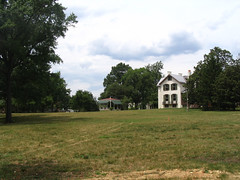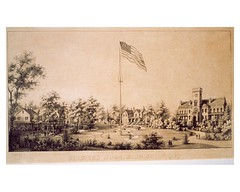by Matt Ringelstetter
 Try and imagine your home or apartment building without its backyard, neighborhood park or tree-lined street. Missing these important landscape features would surely make the character of the structure feel incomplete. In the same way, the area surrounding a historic building like President Lincoln’s Cottage must be treated as a cultural landscape that requires a certain degree of attention.
Try and imagine your home or apartment building without its backyard, neighborhood park or tree-lined street. Missing these important landscape features would surely make the character of the structure feel incomplete. In the same way, the area surrounding a historic building like President Lincoln’s Cottage must be treated as a cultural landscape that requires a certain degree of attention.
Because practically all landscapes have been affected by humans in some way or form, what exactly makes a landscape “cultural?” According to the Institute for Cultural Landscape Studies at Harvard University, a cultural landscape is not a special type of landscape, but instead, “a way of seeing landscapes that emphasizes the interaction between human beings and nature over time.”

The National Park Service defines four basic types of cultural landscapes based on human interactions in a chapter from its “Preservation Briefs” series. First off, a landscape can be considered cultural based on a historic design. These areas are consciously designed within a recognized style or tradition, such as Frederick Law Olmstead’s urban parks. Contrasting this category would be settings that are historic in a vernacular sense. These landscapes reflect characteristics of everyday life and include farmland and rural villages where function rather than form has played an important role. The third type of cultural landscape would be one that is significant for its association with a historic event or person. Finally, a landscape can be viewed in a cultural sense for ethnographic reasons, such as a city neighborhood or sacred religious site.
Looking at the grounds surrounding President Lincoln’s Cottage at the Soldiers’ Home, two of these four interactions are present. The landscape is obviously historic for being the summertime residence of not just Abraham Lincoln, but several other presidents and U.S. policy makers. The Soldiers’ Home was also the first retirement home for United States veterans, and is still in use to this day.
 Besides being a historic site, the cottage and grounds reflect the historic design influences of Andrew Jackson Downing. Believing that one’s well being could be affected by the surrounding environment, he created landscape and architectual plans and ideas that blended man-made structures with the natural world. Downing is often credited with popularizing the porch within American architecture in an effort to accomplish this idea. The well known nineteenth century landscape architect may not have personally designed the grounds to the Soldiers’ Home, but his influence can be seen. When sitting on the porch, or veranda, on the south side of President Lincoln’s Cottage, the tranquility and relaxing character of the landscape that Downing’s ideas strived for, and the President undoubtedly experienced, can truly be appreciated.
Besides being a historic site, the cottage and grounds reflect the historic design influences of Andrew Jackson Downing. Believing that one’s well being could be affected by the surrounding environment, he created landscape and architectual plans and ideas that blended man-made structures with the natural world. Downing is often credited with popularizing the porch within American architecture in an effort to accomplish this idea. The well known nineteenth century landscape architect may not have personally designed the grounds to the Soldiers’ Home, but his influence can be seen. When sitting on the porch, or veranda, on the south side of President Lincoln’s Cottage, the tranquility and relaxing character of the landscape that Downing’s ideas strived for, and the President undoubtedly experienced, can truly be appreciated.
Mr. Matt Ringelstetter is a summer 2007 intern at President Lincoln’s Cottage.
